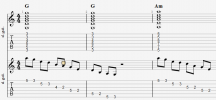Mike A
BLUES NOODLER
in todays all access live Griff was doing caged chord progressions and the the pentatonic scale inside the chords...i have asked people about this and they looked at me like a dog looks at a new bowl..some of you guys were calling it the little wing lesson...can anyone give this a name..i want to understand this and learn how to do it..

